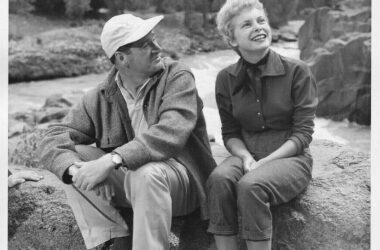On the opening of the picture, ‘Leave To Heaven’ showcases the innovation of its technicolor drama by immediately establishing the ideology of composition within its structure, images and themes. The composure of its deep and dark emotions. Every frame, structured and dramatized like a painting, a never ending canvas of vibrant colors that clash against mystery, judgment and ambiguity. As we wonder what our main character may have done in the beautiful landscapes perfectly framed against its characters in the sharp and mystical technicolor. We have an instigation of prison and societal fascination, leaving both audience and characters interested in what may have happened. With one thing being implied, Richard’s sin and initial mistake was one of sharp and silent guilt, that we are soon to be exposed to
The scene that follows reveals the picture’s female co-star. With a never stopping pacing that manages to have momentum due to the staging (or lack thereof). The beautiful images crafted by John M. Stahl and cinematographer Leon Sharmroy do not worry about where characters stay in relation to each other as much as it worries about portraying each world of their presentation separately yet equally rich. As she puts down her magazine, to reveal the unrealistic daring beauty of Gene Tierney, worlds begins to colide, yet their eyes alone do all the work. The rest of the environment is a mere inconvenience to their undeniable and immediate attraction, and the editing knows it. With Stahl, in similarly fashion to D.W Griffith, a close up, even if silent, means more than a thousand words.
The production design of the picture is nothing short of flawless. The reinvention of the technicolor meant many more vibrant emotions that perfectly suited the musical pictures, yet Stahl used it in visionary fashion to bear the unimaginably complicated and fascinating emotions of the American drama. With sharp lights that dwell in amidst strongly different clothes and environments, with it all possessing only a little of the theatrically of the technicolor’s baby darling that is the musical genre, and yet all of its ingenuity in crafting images deeper than any sea and as complex as the emotions of its characters. Dwelling in their longing, loneliness, confusion, and grief. For a picture that explores such imaginably human characters, one could expect Stahl to rely on film noir and its black and white techniques, yet he reinvents, and challenges himself under a new technology in order to provide you with something different. To twist the ever ethereal life brought up by the colors, adding tragedy and humanity to even the most comforting of dreams.
The steady tracking shorts that end too shortly as the pretension of its characters are put across, relishing in the masks they wear to hide themselves from others, and in some cases, their own reflection.
Richard
Ellen: Of course you have to read between the lines
Richard: What kind of man am I?
Ellen: You’re a bachelor.
The character of Richard Harland is a fascinating one. For a good part of the picture you can’t quite assess a lot of him, yet you can never tell he’s hiding a part of himself like other characters. That is because Harland’s greatest flaws are thrown right in our faces. In a scene where Ellen questions his book (my favorite scene in the picture in terms of lighting) certain details are subtly revealed to us. Ellen doesn’t like secrets, she wishes to guess what Richard hides as we do to the characters themselves, she wishes to feel as if she knows him like no other, using her undistinguished beauty to cover the grief that drives her dependence on Richard. Ellen provokes and challenges him, while Ruth comforts him, she’s an angel in many ways, and Ellen knows this, which is why she resents her, she prefers the side of Richard that is complacent, the side that is dysfunctional as she is, the side that is thrown in front of us as a causality for his downfall.
The casting communicates a man torn between two women: one emotionally unstable, with a beauty that evokes provocation and mystery, alluring, and another that emanates comfort, an angelic beauty, and that is where Richard’s greatest sin begins to so often be thrown at us: complacency. For even if caught and entangled in falsehoods by Ellen, he subtly goes along any of her suggestions up until it begins to harm him.
Colors In A Picture
‘Leave Her To Heaven’ teaches an important lesson. It’s pallet consists of a wildly different canvas. Soothing browns that bathe you in desert settings, making even water appear dry, interiors with such intricate lighting work to depict both the psychology of its figures and the comfort of their homes. While nature is portrayed by colors as all encompassing and somewhat one dimensional, interiors have many dimensions to them. They’re soothing but they’re also sublime and linger over with suggestions of something more. Staging takes second place in order to dress you with steady and singular dynamics, that while as absurd with its lighting and production design as any other early technicolor picture, represents a simulation of the noir under a much different world.
Ellen
“What’s wrong with Ellen?”
“There’s nothing wrong with Ellen, she just loves too much”
She wants Richard all to herself and her darker side, while apparent is also overshadowed by her beauty at the start, perfectly merging later on and transforming Gene Tierney’s story from an emotional face saver, to an evil murderer.
The river, a point much returned to by the picture, represents Ellen’s distant and uglier side that she hides, for her capacity for evil, while associated to her father, also appears somewhat inherent due to its presentation. Gene Tierney’s performance is, in my eyes, one of the great performances in American cinema. Her dialect, marries a script that insinuates such nuance, one would believe any actor that wasn’t spectacular would fail to convey it, transform it and elevate it as she does. Her laughs and smiles, while insinuating something darker, feel as honest as her deep stares and intimidating silences. Her jealousy is human. Her insecurity, justifiable. When Richard claims her to be hysterical, he does so as a man who married a woman because he was comfortable with the mask she so desperately desired to hold for him, yet once in a while, that mask falls, and the part of her that goes unaddressed, unhealed comes out, and due to Richard’s ignorance, worsens. At the end of the day, could one really call crazy a woman whose instincts about her husband while bad, were also somewhat correct, considering he was in fact attracted to Ruth.
Leave Her To Heaven’s script is so masterful because, in one ways more than one, Ellen is correct in her paranoia, and in one ways more than one, she’s a tragic victim. Yet her tragedy only generates ruthless behavior. It’s complex, Ellen takes away much of what it’s important to Richard, with the second time bringing it to question that her need for him is out of nothing but selfishness. This is when Ellen takes a step from victim to active aggressor. In the scene she does, Stahl’s elegant and eloquent close ups elevate you more than the sharpest forms of poetry.
The chilling scene between her and Danny, taken by silence and evil pretense, reveals the consequences of Ellen’s grief, resulting in sociopathy in relation to how much she wants only her and her husband, a man that replaces the image of her dead father. One could even make the argument that by her relationship to Richard, Grief wasn’t a trigger as much as it was a reason. Her complexity as a character comes from desiring to hide the sides of her that need to heal, the ones that relate to her loneliness, to her obsession, jealousy and even rightful indignation. Ellen is the most complex character and performance of the entirety of the 50s, yet the picture progresses your understanding of her in a way so that you can assert a more engaging morality to it by the end.
“Ellen always wins”
Or does she.
Related Posts
Agnés: From 5 To 7
In Agnes Varda’s “Cleo From 5 To 7” the filmmaker dwells upon the nature of symbolism and her…
Anthony Mann – Genre Fanatic Renaissance Man
It appears Anthony Mann can do anything. His mature approach towards the western genre could hold the attention…
Saving Private Ryan: The Weaknesses of Spielberg
My first time watching since I was 13 after reading Anthony Beevor’s excellent book about D-Day. Saving Private…


